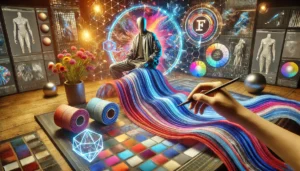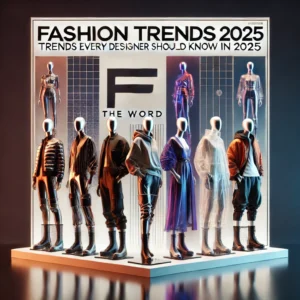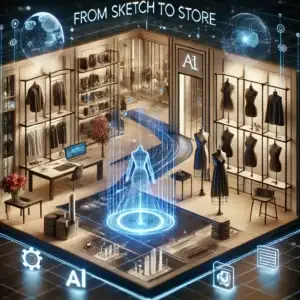Seemingly long ago, fashion shows were the pinnacle of fashion marketing. But the once-exclusive world of fashion has changed.
Today’s tech-savvy consumers crave instant gratification and innovative experiences beyond the traditional runway. In response, brands are embracing digital strategies such as AI-powered fashion design, AR fashion showcasing, and fashion NFTs. Tech innovates the way we showcase collections, connect with audiences, and drive sales.
Physical limitations no longer confine fashion shows. We can transport potential customers into captivating virtual environments where they can explore 3D fashion collections in detail.
Beyond the Runway: Immersive Virtual Showrooms in Online Fashion Retail
Virtual showrooms offer a world of possibilities, allowing your collection to shine in a digital environment accessible to all users. Create interactive 3D spaces with digital design tools where customers can explore garments in incredible detail, experience diverse colorways and styling options, and even visualize themselves wearing them with AR virtual try-on technology.
As online fashion retail continues to expand, virtual showrooms enhance the shopping experience by bridging the gap between physical and digital shopping. Customers can zoom in on intricate embroidery or see the flow of a dress on a virtual model. This interactivity fosters a deeper connection with the clothing and helps customers make purchasing decisions. Major brands are investing heavily in the digital fashion market, and the metaverse continues to grow its influence. The immersive fashion market is anticipated to reach $9.9 billion by 2032.
Blurring the Lines: Augmented Reality (AR) Experiences
According to Deloitte research, 40% of shoppers would pay more if they could test a product through AR, and 61% prefer stores with AR.
This technology allows customers to view garments superimposed onto their surroundings through smartphone cameras. Imagine your customer visualizing how a jacket looks with their favorite pants or how a necklace completes their outfit.
AR closes the gap between digital and physical, making shopping more engaging and fun. Incorporating AR fashion apps enhances interaction and engagement.
Harnessing Digital Power: Social Media Domination
In 2024, e-commerce sales are expected to grow 8.8%, and this market is projected to total $6.3 trillion.
Leverage platforms like Instagram, TikTok, and Pinterest to share your design process, behind-the-scenes glimpses, and buzz-worthy teasers, engaging with your audience in real-time. You can also partner with fashion influencers, run interactive polls, host live sessions, and encourage user-generated content with creative hashtag campaigns. Social media is ideal for cultivating a vibrant online community to foster brand loyalty.
Empowering Your Customers: User-Generated Content
Encourage your customers to become your biggest advocates through content of their own. You can do this through contests, challenges, and campaigns inspiring people toward actions like sharing their styling of your clothing lines or what they have learned from you. When you host events, encourage them to post about their participation.
User-generated content provides valuable proof and fosters a sense of authenticity and community. When potential customers see real people wearing your clothes, working with them, admiring them, and advocating for your brand, it builds trust and inspires purchases. You can also showcase the best user-generated content on your social media and website, celebrating your customers and showing them you appreciate them.
The Future of Fashion: Integrating NFTs and Web3
You have probably heard about NFTs (Non-Fungible Tokens) and Web3. We know these concepts are not the easiest to comprehend, so keep reading our blogs to learn about them and their transformative role in fashion.
Embracing digital ownership with NFTs puts brands ahead of the curve. You can issue unique digital certificates for limited-edition garments or offer exclusive digital wearables for avatars in popular online games and limited-edition digital collections that can be traded. NFTs are a new frontier for fashion, offering exciting possibilities for brand innovation and customer engagement in a new digital marketplace.
FAQs
- How are fashion shows evolving in the digital age?
Traditional fashion shows, once the pinnacle of fashion marketing, are evolving into immersive digital experiences. Brands are leveraging digital strategies like AI-powered design, augmented reality (AR), and fashion NFTs to engage consumers. These technologies allow brands to showcase their collections beyond the runway, reaching wider audiences through interactive and immersive virtual environments. - What are virtual showrooms, and how do they benefit fashion marketing?
Virtual showrooms are interactive 3D spaces where customers can explore fashion collections in detail. These digital environments offer opportunities to zoom in on clothing features like embroidery, experience different colorways, and visualize how the clothes look on virtual models or through AR try-ons. Virtual showrooms create deeper customer engagement, allowing for a more personalized shopping experience and better purchasing decisions. - How does augmented reality (AR) enhance the fashion shopping experience?
AR allows customers to visualize garments overlaid in their real-world surroundings using smartphone cameras. For instance, shoppers can see how an outfit looks with their existing wardrobe or how accessories complement their outfits. This creates a more engaging shopping experience, bridging the gap between the physical and digital worlds, and making fashion more accessible and fun. - What impact does social media have on fashion marketing today?
Social media is a crucial tool for fashion brands to engage directly with customers in real-time. Platforms like Instagram, TikTok, and Pinterest allow brands to showcase their design processes, behind-the-scenes content, and product teasers. Brands can also collaborate with influencers, run interactive campaigns, and encourage user-generated content (UGC) to foster brand loyalty and increase reach. - How does user-generated content (UGC) contribute to brand growth?
User-generated content (UGC) helps build authenticity and trust in a brand. When customers post about their experiences, such as styling clothes or attending brand events, it serves as social proof for potential buyers. UGC creates a sense of community and empowers customers to become brand advocates. By sharing UGC on social media and websites, brands can celebrate their customers and strengthen brand relationships. - What role do NFTs and Web3 play in the future of fashion marketing?
NFTs (Non-Fungible Tokens) and Web3 technologies are revolutionizing digital ownership in fashion. By offering exclusive digital items, such as limited-edition garments or digital wearables for avatars, brands can create new forms of customer engagement and drive innovation. NFTs allow customers to own unique digital assets, enhancing brand loyalty and opening up opportunities in virtual marketplaces.
Have you tried these strategies? Tell us about your experience in the comments below!



